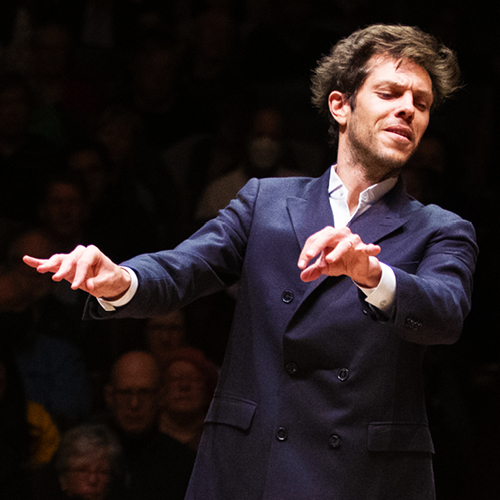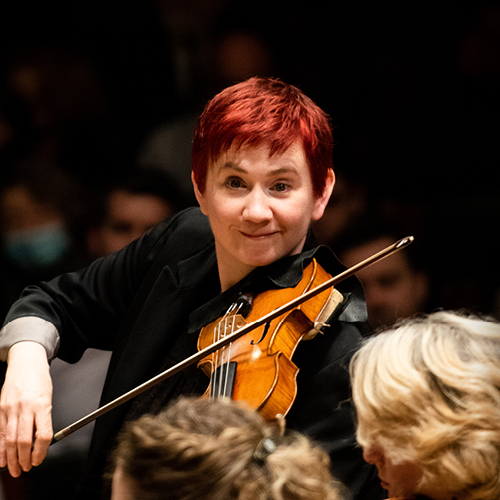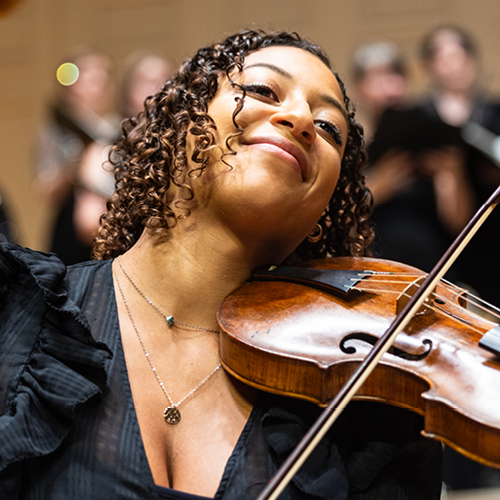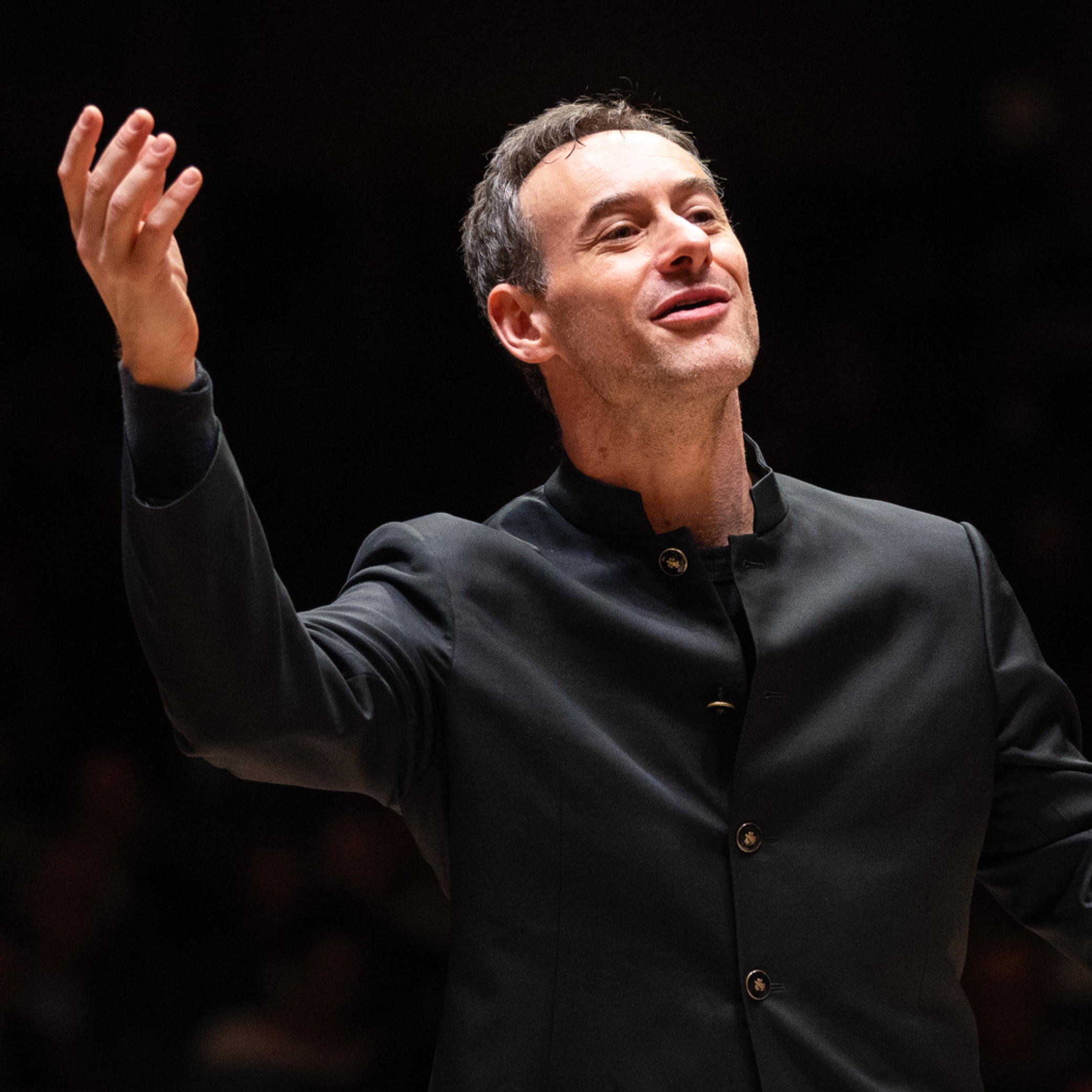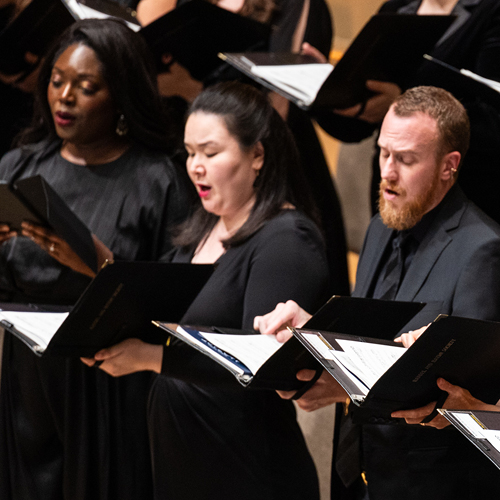
Program Notes
Every voice
What makes a piece of music “good”? Is it that it has a good melody or a catchy rhythm? Is it that the performance was moving to everyone who heard it? Is it that other people (or people in authority) say it is good?
What makes a piece popular? Is it that the piece is “good”? Is it that something about it is memorable? Is it that it has been played many times and is therefore familiar?
The beautiful thing is that the world of music makes room for all of these. There is a time for pieces that are familiar and also for pieces that are new. There is enough space for moving performances, good melodies, catchy rhythms, rituals that are comforting (especially in difficult times) and opportunities for something unfamiliar and exciting. The canon of western classical music has extended these privileges to geniuses like Bach, Vivaldi, Handel, Mozart, Haydn, Beethoven, Brahms, and countless others, but when it comes to the world of women composers, “unfamiliar and exciting” is too often the norm. Separating composers into categories by gender can serve the positive purpose of praising them and highlighting their accomplishments (as is the goal of this program), but too often such separation removes the work of women from the central narratives of classical music. When this happens, their work loses its musical worth and retains value only as a side story to the accomplishments of those who fit mainstream expectations. Unlike the 19th Amendment, which only extended voting rights to a certain “acceptable” group of women, it is time to fully include all womxn in the story. Every composer presented here is a master of her own style and a tremendous force of genius. They represent different times, different traditions, and different voices, and without them the musical world is incomplete.
Isabella Leonarda (1620-1704) was born into a noble family in Novara, Italy in 1620, making 2020 her 400th anniversary year. She entered the Collegio di S Orsola, an Ursuline convent, in 1636 where she went on to hold positions as music instructor, mother superior, and counsellor for her community. At a time when women were more frequently known as performers, Leonarda received wide-spread acclaim as a composer. She gained particular recognition for being the first woman to publish instrumental sonatas (in 1693), but her published works include examples of nearly every sacred genre of the time. With about 200 compositions dating from 1640 all the way to 1700, her works clearly demonstrate her tremendous versatility and mastery of the different styles prevalent in Italy during that period. “Venite laetantes” from Motetti a voce sola con istromenti, Op. 20 was published in 1700. A reworking for alto of an earlier piece for solo soprano published in 1687, Leonarda’s solo motets borrow stylistically from secular genres and provide more dramatic opportunities for the performer than her other liturgical works. This unique first-person Marian text (likely written by Leonarda herself) welcomes the faithful, promising them peace and heavenly delight.
Composer and singer Mari Esabel Valverde (b. 1987) is fascinated with how ink on a page can be reinterpreted into a world of sound. She began composing in the eighth grade, later studying at St. Olaf College, the European American Musical Alliance in Paris, and the San Francisco Conservatory of Music. Primarily known for her choral music and art songs, her works explore social justice and contemporary issues. Prélude en la-bémol majeur: Allegretto, léger, en volant (Prelude in A-Flat Major: Allegretto, lightly, flying) was composed as part of a project for the San Francisco Conservatory of Music. Her mentor, David Conte, asked composers who were also his former students to write reflections/responses to the Chopin preludes. The title is in French, reflecting both the link to Chopin and also the great affection Valverde holds for the French Impressionistic school – an obsession with Debussy’s Première Arabesque inspired her to teach herself to play the piano. In composing this piece, she sought to reflect the mood and shapes of the Chopin Prelude in A-Flat, essentially presenting her version of that same story.
With the unwavering support of her mother, Zenobia Powell Perry (1908-2004) pursued a career in music, first studying with William L. Dawson at the Tuskegee Institute and later with Darius Milhaud at Wyoming University. Homage was dedicated to her former teacher, William L. Dawson, on the occasion of his 90th birthday in 1990, and was the last piece Perry wrote for piano. Incorporating the spiritual “I’ve been ‘buked and I’ve been scorned” (Dawson’s favorite spiritual tune), the piece weaves together Perry’s masterful style with the rich traditions of the spiritual which were an influence on her from an early age. With a theme of persistence in the face of unthinkable difficulty, the piece is a tribute to the important mentoring relationship between teachers and students as well as all who encourage others on their creative journey.
Conductor, singer, and composer Zanaida Stewart Robles (b. 1979) is a fierce advocate for diversity and inclusion in music education and performance. Born, raised, and educated in Southern California, she is on the national board of the National Association of Negro Musicians, and is chair of the board of directors of Tonality, a non-profit organization that promotes peace, unity, and social justice through choral music performance in Los Angeles. “Kuumba,” like “Umoja” from last year’s Every Voice program, is from a set of songs which reflect on the principles of Kwanzaa – kuumba describes creativity or creation, while umoja describes unity. The creator of Kwanzaa, Dr. Maulana Karanga, defines the principle of kuumba as the need “…to do always as much as we can, in the way we can, in order to leave our community more beautiful and beneficial than we inherited it.” In this season of tremendous upheaval, Concert Choir has adopted kuumba as a mantra, reminding the singers, audience, and the greater community that creativity remains as vibrant as ever, regardless of external circumstances. In composing “Kuumba,” Dr. Robles first taught the underlying theme to the congregation of her church. While the entire congregation was singing this ostinato, members were encouraged to improvise a melody if they felt moved to do so. The solo line in the Concert Choir’s performance is a transcription of the improvisation from that day. In a different setting, the score calls for singers to improvise a solo line to fit the moment of performance, making “Kuumba” an overwhelming celebration of creativity and community.
The idea of creation or creativity is often depicted as being feminine/female, sometimes in contrast with the masculine/male representing destruction or aggression. In presenting this program of female composers, we are celebrating this triumphant spirit of creativity – one that persists in the face of restrictions, limitations, and prohibitions, and one that is not limited to any one people, gender, genre, or medium. It is the same creative spirit that inspires great painters, sculptors, architects, dancers, musicians, actors, writers, and composers, and the same creative spirit whether it appears in the works of J.S. Bach and George Frideric Handel or those of Amy Beech and Florence Price.
In June of 1933 the Chicago Symphony Orchestra premiered a new symphony which had won a recent competition and been praised by critics. In that moment, Florence Price (1887-1953) became the first Black woman to be recognized as a symphonic composer and also the first to have an orchestral work performed by a major symphony orchestra. Originally from Arkansas, Price studied at the New England Conservatory before eventually moving to Chicago. Her compositions began to win awards in the 1920s and after the Chicago Symphony Orchestra premiere she gained further recognition when her arrangement of “My soul’s been anchored in de Lord” and “Song to the Dark Virgin” were performed by Marian Anderson. In addition to her classical compositions, she played for silent films, wrote popular music for commercials, and made orchestral arrangements for the WGN Radio Orchestra in Chicago. Her unique compositional voice, a perfect hybrid of the European classical style and Black American musical traditions, provides a glimpse of what might have been if the American classical style had developed without further European influence. The three songs on this program (“A White Rose,” “Out of the South Blew a Wind,” and “Song to the Dark Virgin”) are taken from her extensive collection of art songs and demonstrate her exquisite artistry – every note means something, nothing is out of place, and the most is made of every moment from the beginning of the piece to the end.
The extraordinary talents of Amy Beach (1867-1944) were obvious early in her childhood and her affluent family ensured that she was supported and surrounded by those who could nurture and guide her. She made her debut as a pianist with the Boston Symphony Orchestra in 1885 playing Chopin’s F Minor Concerto, but after her marriage to Henry Harris Aubrey Beach she followed the wishes of her husband and focused on composition rather than performance. Her works were premiered by the Handel and Haydn Society and Boston Symphony Orchestra, among others, and almost all of them were published, including her multitudes of commissioned works for various ensembles. After her husband’s death in 1910 she returned to her path as a performer, using recital appearances to establish her reputation and support the sale of her compositions both in America and in Europe. The Five Improvisations, Op. 148 were written in 1938 while she was living at the MacDowell Colony in New Hampshire and are some of her most adventurous writing, exploring atonality while still remaining true to the lyric style she developed composing art songs early in her career.
We are living in a season of limitations – limits on gatherings, on travel, on contact with others, on the ability of musicians (and others in the arts, entertainment, and hospitality industries) to continue working, on purchasing everyday items at the store, on living our lives as we ordinarily would – and all of this because of circumstances beyond our control. In a way, there is no better time than now to explore the world of female composers for that is also a story of limitation and restriction, of minimization and erasure. We look forward to presenting the full program, including works by Ethel Smyth, Juana Inez de la Cruz, Margaret Bonds, and nine other exceptional women at some point in the future. In the meantime, we offer this as a unique moment to reflect on the consequences of limitations on our greater community. Not only is this an important moment and opportunity to make change, we have a tremendous obligation to do so. We cannot move forward unless we all move forward together.
In this spirit, “Lift Every Voice and Sing” closes this year’s Every Voice program, as it has since the beginning. Written by James Weldon Johnson and set to music by his brother J. Rosamond Johnson, the NAACP adopted the song as the Black National Anthem shortly after its composition. It was premiered by a choir of 500 schoolchildren as part of a celebration of Lincoln’s birthday in Jacksonville, Florida in 1900, and is presented here as a call for us to share a moment of unity, joining with the struggle of those voices represented by this program to seek a better future together.
Elise Groves, November 2020
Information drawn from Grove Music Online, the websites of Zanaida Stewart Robles, Mari Esabel Valverde, and Jeannie Gayle Pool (Zenobia Powell Perry’s biographer), as well as interviews with Reginald Mobley, Jennifer Kane, Julia Scott Carey, and Mari Esabel Valverde

